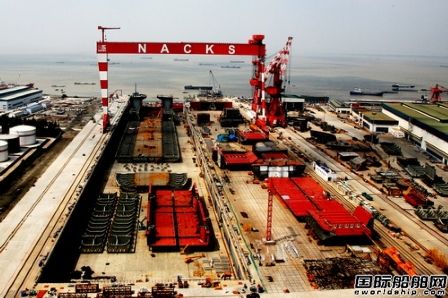World’s largest container ship docks at Vietnam’s Cai Mep

The event marked a memorable point of the Vietnam’s maritime industry affirming the position of Cai Mep-Thi Vai seaport complex in the world in international shipping transit operations.
The ship was on its way to transport goods from Asia and Europe, docking at Cai Mep to load and straightly transport Vietnamese goods to Europe. The straight route reduces the journey by day and costs by 10-20 percent compared to transit route in other nations. Last year, the port handled ships of 150,000 to 165,000 tons for 68 times.
Since September 2015, Cai Mep International Terminal Company had sent a report seeking the Ministry of Transport’s approval to test the handling of 18,000 TEU Triple-E ships at CMIT.
Determining that port’s handling of such large vessels plays a significant role in Vietnam’s seaport development strategic, deputy Minister of Transport Nguyen Van Cong worked with relevant agencies including Vietnam Marine Administration, Maritime Administration of Vung Tau and Southern Vietnam Maritime Safety Corporation, navigator units and Portcoast Consultant Corporation to seek solutions for the type of ships to enter the port safety.
Deputy director general of Portcoast Pham Anh Tuan said that the firm together with CMIT had carefully studied and prepared for the important event under the instruction of the Ministry of Transport and relevant agencies since September 2016.
The landing of Margrethe Maersk on February 20th proved the ability of CMIT and Vietnam to become a transit center of cargo from Asia to Europe and contributed in materializing the Government’s policy of developing Cai Mep seaport complex into an international container transit center, said director general of CMIT Robert Hambleton.
Portcoast has completed an overall study to expand a fairway to facilitate large vessels’ travel in and out from Cai Mep-Thi Vai seaport complex contributing to the country’s sea economic development as per instruction by the ministry.
According to Vietnam’s seaport development plan by 2020 approved by the Prime Minister in 2014,
Cai Mep container seaport complex comprising CMIT, Tan Cang Cai Mep Thi Vai Terminal (TCTT) and SP-SSA International Terminal (SSIT) in the southern province of Ba Ria-Vung Tau is the deep seaport complex and international entrance gateway of Vietnam. They can handle vessels of 100,000 tons.
Up to 30 percent of Vietnam’s container goods exported to European markets must be transit in Hong Kong, Singapore and Malaysia increasing transport time and costs for many years.
In June 2011, the Prime Minister instructed relevant sides to focus on investing in container seaports in Cai Mep area to develop the area into the southern international entrance gateway, meeting cargo export import to far markets and performing the role of international transit role.
Six years after the first container wharf of Cai Mep seaports came into operation, the volume of container goods via the complex reached 1.36 million TEU in 2015. The number was up 47 percent in the following year to top two millions TEU.
CMIT was one of four winners of Lloyd’s List Awards 2016 in Singapore last October. CMIT is a dedicated container terminal invested by international container terminal operator APM Terminal, Saigon Seaport and Vietnam National Shipping Lines (Vinalines) in the lower reaches of the Cai Mep river. The port’s quay length totals 600 meters.
The first time it received container vessel was in March 2011. The ship had the deadweight of 131,000 DWT and the capacity of 11,388 TEU. In December of the same year a 14,000 TEU vessel which was one of the biggest container ships in the world at that time successfully entered the port.
Afterwards CSCL Star vessel of 14,074 TEU docked at the port in October 2015. From that the port continued handling vessels of 160,000 to 165,000 tons. Following these successes, CKYHE alliance chose the port to handle a fleet of mega ships in Asian and European maritime routes in October and November 2015.
Source: Saigon
HEADLINES
- Do shipping markets want Biden or Trump for the win?
- All 18 crew safe after fire on Japanese-owned tanker off Singapore
- Singapore launching $44m co-investment initiative for maritime tech start-ups
- Cosco debuts Global Shipping Industry Chain Cooperation Initiative
- US warns of more shipping sanctions
- China continues seaport consolidation as Dalian offer goes unconditional